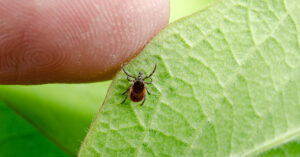 Sometimes, we believe that just because we weren’t aware of something previously, it must be new. Many people feel that way about Lyme disease.
Sometimes, we believe that just because we weren’t aware of something previously, it must be new. Many people feel that way about Lyme disease.
They believe that because the tick-borne disease has been well-publicized in the last few decades, that must be when it started. Unfortunately, that’s not true.
Unlike the SARS virus and various flu viruses that mutate and expand their ability to infect people, Lyme disease is not caused by a virus but a bacterium that hasn’t changed much in the last 60,000 years.
Has Lyme Disease Evolved?
Scientists at Yale School of Public Health conducted in-depth research into the origins of Lyme disease. The prestigious school was interested in the threat to public health because modern knowledge of the disease originated near them. The condition is named after Lyme, Connecticut, where the symptoms were first described in 1976.
Researchers found that the bacterium hasn’t changed much over the centuries, but the ecology of North America has changed a lot. As more primordial forests were eliminated and people moved into lands that were once forests, they also began to co-exist with the deer population.
Almost no one is surprised these days to see deer in suburban areas eating lawns or flower beds, but few people make the connection between those big, brown-eyed herbivores and the tiny deer ticks that carry Lyme disease. With the help of birds and small mammals, Lyme disease bacterium has spread across much of the country.
The Centers for Disease Control and Prevention estimated that Lyme disease is the most common “vector-borne” disease, with 300,000 to half a million Americans infected every year. The good news is that when recognized early and treated, doctors can cure Lyme disease.
Does the CDC Recognize Chronic Lyme Disease?
The key to Lyme disease treatment and recovery is getting diagnosed early. After a person has been exposed via the bite of a black-legged tick, the disease’s first signs and symptoms are fever, chills, or a headache. In about three-quarters of patients, the bullseye rash people have come to associate with Lyme disease will appear.
Unfortunately, about one in five people infected with Lyme disease will never have a rash at all, and some of those who do will have a rash that doesn’t look like people think a Lyme disease rash will look. A blood test is the only way to verify if a person has contracted Lyme disease.
When diagnosed, patients are given antibiotics for up to two weeks. People who take these antibiotics usually recover completely and quickly. Most people not treated with antibiotics also recover fully, just more slowly as the body fights off the infection itself.
But what about the ones who don’t?
People who contract Lyme disease but don’t know it can have muscle aches, chills, and even mild heart palpitations months after exposure. This so-called chronic Lyme disease is not currently recognized by the CDC or the National Institute of Health. Researchers say so-called chronic Lyme disease is poorly defined and may encompass various related conditions that started with Lyme disease but are not part of an active infection.
Because the disease became common in people within the last 50 years, more research is necessary to study the long-term effects and if they ever subside. And while it is not a broadly recognized medical condition today, that does not mean it might not be in the future.
Call East End Tick Control® to Protect Your Family from Lyme Disease
The best way to prevent short-term or long-term Lyme disease is to avoid tick bites, and one way to do that is to consider tick control in the outdoor spaces near your home or where you spend time. For more information on tick control services, please call us today. If you are located near Southampton, call (631) 287-9700. If you are closer to East Hampton, call (631) 324-9700. Southold residents can call (631) 765-9700. You can also email us.
A Brief History of Lyme Disease in NY
Serving Southold





